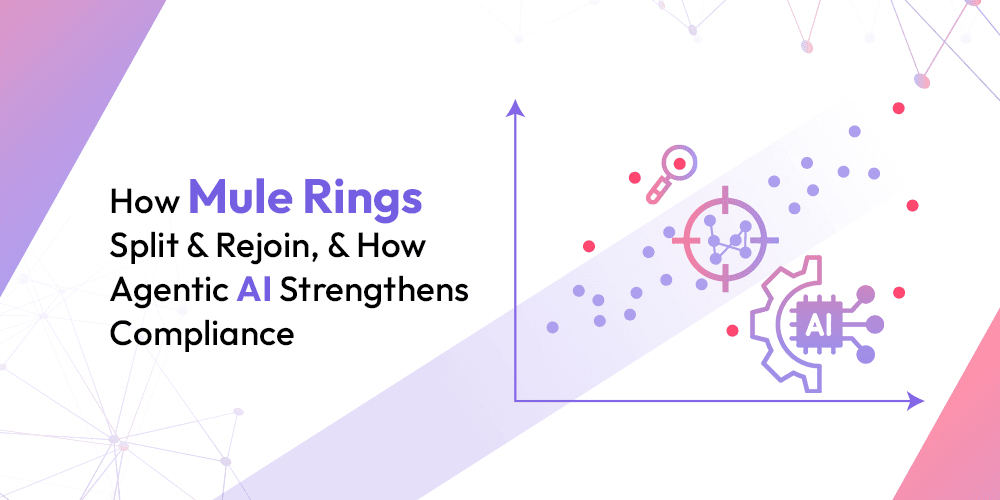
How Mule Rings Split & Rejoin, And How Agentic AI Strengthens Compliance
RaptorX.ai
Monday, September 15, 2025
The Evolution of Mule Rings
In today’s financial ecosystem, fraud rarely operates in isolation. Instead, it thrives within mule rings, webs of interconnected accounts used to launder money across borders, institutions, and industries.
What makes mule rings particularly elusive is their ability to split and rejoin. Unlike simple fraudulent transfers, these networks adapt dynamically:
- Splitting: When surveillance pressure rises, mule handlers disperse activity across smaller account clusters. Transactions appear fragmented and less suspicious.
- Dormancy: Certain mule IDs fall silent, creating the illusion of inactivity.
- Rejoining: After multiple hops, dormant accounts suddenly reconnect downstream, consolidating flows in ways that mimic legitimate financial behavior.
This behavior is not random; it’s a calculated tactic designed to exploit blind spots in compliance monitoring.
The Mechanics of Splitting and Rejoining
A common pattern observed in mule rings is that an account may go dormant and then reappear four hops later in the transaction chain.
- At first glance, these hops appear to be disconnected transfers.
- When rejoining occurs, the dormant ID is seamlessly stitched back into the network.
- This evolution creates the perception of fresh, unrelated activity—masking the continuity of laundering.
In visualization, arrows across entities show how money travels through nodes, disperses, and later converges. Over time, the pattern evolution of these rings reveals them to be less like straight pipelines and more like living networks that adapt to pressure.
Why These Challenges Compliance Teams
For compliance officers, the challenge is twofold:
- Time and Scale — Tracking entities across multiple hops quickly becomes unmanageable. What looks isolated in the short term may in fact be a reconnection of prior flows.
- Behavioral Masking — Dormant accounts are treated as low risk when inactive, yet their return downstream often goes unnoticed until funds are consolidated.
The result is delayed detection, higher exposure, and in many cases, financial penalties for missed activity.
Reframing the Problem Through Pattern and Intent
To counter this, detection must move beyond surface transactions and instead examine the underlying patterns, behaviors, and intents behind financial flows. Mule rings are not just moving money; they are executing strategies to stay hidden.
This means compliance is no longer about spotting a single suspicious transfer but about understanding:
- Behavior Analysis — How entities behave when they split, lie dormant, and return.
- Intent Analysis — Why funds take specific multi-hop paths that reconnect at certain points.
- Pattern Analysis — How networks evolve over time and across entities.
How RaptorX Helps Compliance Teams
This is where RaptorX comes in. Built around agentic AI and advanced graph intelligence, it enables compliance teams to see mule rings not as scattered dots, but as living networks with evolving strategies.
- Graph and Network View: RaptorX reconstructs entity interactions across hops, exposing dormant IDs that reappear downstream.
- Behavior Analysis: It studies the way mule accounts fragment and reconnect, identifying activity that mimics normal flows but hides illicit consolidation.
- Intent Analysis: By evaluating the direction and purpose of flows, it distinguishes genuine customer activity from orchestrated ring behavior.
- GNN (Graph Neural Networks): These allow the platform to capture complex, non-linear patterns, uncovering rings that adapt, split, and rejoin in ways invisible to linear transaction monitoring.
The advantage is clarity: instead of chasing isolated alerts, compliance officers see the whole structure of evolving mule rings, including when and how they regroup after fragmentation.
Why Agentic AI Is a Turning Point
Unlike static systems, RaptorX is designed to act, adapt, and analyze continuously, much like the mule rings themselves. This agentic approach allows the platform to:
- Track networks over time rather than in snapshots.
- Anticipate reconnections by observing intent and behavior.
- Reduce false confidence in dormant accounts that later rejoin laundering flows.
This isn’t just a detection upgrade, it’s a shift in compliance thinking, one that matches the evolving nature of fraud with equally adaptive intelligence.
Closing Thoughts
Mule rings that split and rejoin are one of the most sophisticated threats facing banks today. Their ability to fragment, lie low, and re-emerge after several hops makes them invisible to compliance programs focused only on immediate activity.
RaptorX addresses this head-on. By combining agentic AI with pattern, behavior, and intent analysis on graph and network structures, it gives compliance teams the tools to see beyond transactions and into the strategies fraud rings use to survive.

